By Joss Whedon, et al. | Published by Dark Horse
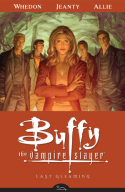 Because I’ve spent so much time and energy in the attempt to quantify why and how Season Eight lost me, I find myself sorely tempted to dismiss this final volume with a simple “meh,” but I suppose I can summon one more burst of effort.
Because I’ve spent so much time and energy in the attempt to quantify why and how Season Eight lost me, I find myself sorely tempted to dismiss this final volume with a simple “meh,” but I suppose I can summon one more burst of effort.
This volume comprises the last five issues of Season Eight (#36-40) and also includes a fun Riley one-shot by Jane Espenson called “Commitment through Distance, Virtue through Sin.” When last we left off, Buffy had turned down sex-spawned paradise to return to this dimension and help her friends fend off the demons that poured in once her mystical boinkage with Angel created a new universe. Then Spike showed up.
As usual, the arc actually starts off pretty well. We see how Angel was convinced (by a talking dog who gets some great lines of Whedon dialogue) to take up the Twilight cause, and some of how Spike became involved. (Please note at this point that Spike has just apparently read Buffy’s name in the newspaper, where she is labeled a terrorist. This will be relevant in a moment.) Now with Buffy and the others, Spike says that “the seed of wonder,” the source of all magic in the world, can stop all of this. And it just so happens to be in the Sunnydale Hellmouth, guarded by the revived Master.
So everyone goes there or maybe they were there already. I have honestly lost track. Anyway, Twilight is very displeased that its parents have abandoned it, and while Buffy and friends are ostensibly protecting the Seed, Twilight possesses Angel and makes him attack Buffy. Long story short: Giles attempts to kill Angel with the scythe, but it’s absolutely hopeless and Angel breaks his neck (just like Jenny Calendar). Buffy, mad with grief, has just had enough and she breaks the seed, severing the connection between this world and magic. Willow, who had possibly been making some headway against the attackers, is promptly stripped of her powers. Though I often criticize Georges Jeanty’s art, Willow’s expression at this moment is some of his best work.
 Issue #40 picks up four months later and largely serves to set up Season Nine. Buffy is crashing on the couch at Dawn and Xander’s San Francisco apartment, working in a coffee shop and routinely dealing with confrontations with Slayers and Wiccans who feel that she betrayed them. Dawn has gone back to school and Xander has once again found gainful employment in construction. Giles left everything to Faith in his will (ouch!), including a London flat. She is also apparently the only one willing to care for a catatonic Angel, which I think is pretty awesome. Given their affinity, it makes perfect sense that she’s the one willing to forgive him when no one else can so much as even look at him.
Issue #40 picks up four months later and largely serves to set up Season Nine. Buffy is crashing on the couch at Dawn and Xander’s San Francisco apartment, working in a coffee shop and routinely dealing with confrontations with Slayers and Wiccans who feel that she betrayed them. Dawn has gone back to school and Xander has once again found gainful employment in construction. Giles left everything to Faith in his will (ouch!), including a London flat. She is also apparently the only one willing to care for a catatonic Angel, which I think is pretty awesome. Given their affinity, it makes perfect sense that she’s the one willing to forgive him when no one else can so much as even look at him.
So. Here are the things I disliked about all of this:
1. I swear sometimes that Whedon is actively trying to get me to hate Buffy. In issue #31, she confesses her love for Xander. In issue #34, she boffs Angel. In issue #36, she is still glowy about that, despite the havoc that ensued. “You gave me perfection and you gave it up. That’s not just the love of my life. That’s the guy I would live it with.” Um, did you forget the 206 girls he killed to get to that point? I can buy Faith’s actions so much more easily than Buffy’s because though she forgives him, it’s not like she’s forgotten all that he’s done.
As if this weren’t bad enough, in issue #37 Buffy is talking with Spike and begins daydreaming about making out with him. A throwaway comment suggests that perhaps this is a remnant of Twilight mind control, and I hope that’s true. I’m not suggesting that Buffy is usually virtuous or that she doesn’t make some impulsive choices when lonely, but holy crap. What a horndog!
2. Remember that newspaper that mentioned “terrorist Buffy Summers”? Well, how is Buffy able to resume life in San Francisco under her own name? In a recent Q&A, Scott Allie says “Buffy didn’t become a household name,” but issue #36 sure seems to indicate otherwise.
3. So far, I feel nothing about Giles’ death. It just doesn’t feel real. There wasn’t enough impact or something. Hearing his will helped it sink in more (and he gets a middle name: Edmund), but, odd as it sounds, I want to be sobbing over this, and I am not.
Now, that’s not to say that there aren’t good things in this volume. Looks like there’s 3 of those, too.
1. There are some great scenes between pairs of characters. Giles and Buffy have a nice scene and Giles and Xander do, as well. Probably my favorite scenes involve Spike and Buffy, though, because he is pretty frank concerning how disgusting he finds everything.
Spike: Under all that demon viscera, you still reek of him, and that’s not a treat for me—but it can’t be Buffy if she doesn’t bonk the bad guy, right?
Buffy: Snark!
Spike: Comes with the sizable package.
As mentioned, Willow’s grief is pretty amazing, and Kennedy haters will rejoice to learn that Willow soon breaks up with her. Less awesome is the throwaway reveal that Willow possibly loved her sexy snaky mentor, whom she will now never see again thanks to Buffy.
 2. The fulfillment of the “betrayal” issue. Back in issue #10, Buffy and Willow went to visit a… seer or something, who shows Buffy a glimpse of herself (a pose that is finally realized in issue #39 after the seed has been destroyed) and says that it’s due to “Betrayal. The closest, the most unexpected.”
2. The fulfillment of the “betrayal” issue. Back in issue #10, Buffy and Willow went to visit a… seer or something, who shows Buffy a glimpse of herself (a pose that is finally realized in issue #39 after the seed has been destroyed) and says that it’s due to “Betrayal. The closest, the most unexpected.”
At first, I was kind of annoyed that the traitor was not conclusively identified, but the more I thought about it, the more I realized this is quintessential Whedon. Buffy betrayed everyone by boinking the enemy, bringing down demon hordes, and then ridding the world of magic. Buffy and Angel betrayed the new universe they created. Angel betrayed Buffy by killing Giles… Ultimately, I think the prophecy refers to Buffy herself, but it’s kind of neat that it can be interpreted in several different ways.
3. One might not expect a one-shot prequel starring Riley and his wife Sam to be kind of awesome, but this one is. It’s full of great dialogue (and when I mentioned my favorite line to Jane Espenson on Twitter she actually replied!) and reminds us once again why Sam is so fantastic. I think I now want a mini-series focusing on these two as they are occasionally summoned away from bucolic corn-growing bliss to save the world.
So now the big question is… will I read Season Nine?
While there were some things I disliked about earlier arcs in Season Eight, Brad Meltzer’s penultimate “Twilight” arc was the proverbial straw that broke the fangirl’s back, and I resolved to stay away from further Buffy comics once this particular season had wrapped up. Advance press for Season Nine, however, has made me change my mind.
Season Nine just sounds so much more like something I’d want to read (and will be co-written by Andrew Chambliss, who penned my favorite Dollhouse episode, “A Spy in the House of Love”). For example, the synopsis for the second issue begins “Buffy continues her nightly patrols while trying to cobble together a sensible life…” That sounds great to me! Much better than all this big-budget sprawl. And the Angel and Faith companion series sounds like it could be even better!
I may end up disappointed, but I just don’t think I’ll be able to resist.


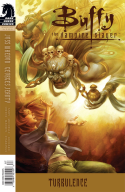
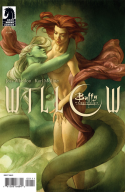

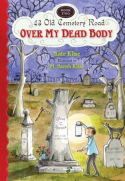
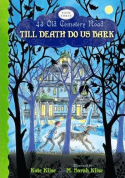
















Recent Comments